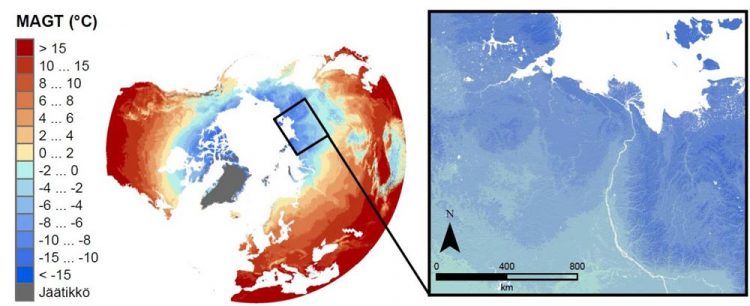More detailed data on thermal conditions of Arctic ground

The findings from the research will enhance our understanding of the fine-scale variation in thermal conditions in the ground of the northern hemisphere. MAGT=mean annual ground temperature. Credit: Juha Aalto
Understanding the thermal conditions of the ground in the Arctic is of utmost importance in order to assess the effects of climate change on the occurrence of permafrost, on the ecosystems and societies of Arctis, and the global climate system.
Juha Aalto and Miska Luoto, researchers in natural geography at the University of Helsinki, participated in this study. The findings of the study have been published in the international journal Geophysical Research Letters.
The research has been carried out by Juha Aalto and Miska Luoto (Department of Geosciences and Geography, University of Helsinki / Finnish Meteorological Institute), and Olli Karjalainen and Jan Hjort (Geography Research Unit, University of Oulu).
Support from statistical methods
The research modelled the temperatures of the ground and the thickness of the active layer, i.e. the layer above the permafrost, which thaws in summer. The study covered most of the northern hemisphere.
The modelling was based on a database combining very extensive field measurements and digital environmental data. The study utilised statistical ensemble methods with a spatial resolution of 1km2, an accuracy hitherto unseen.
“This is a significant step forward, as previous studies have only been able to provide a very general overview of the thermal conditions of Arctic ground and their changes,” says Postdoctoral Researcher Juha Aalto.
Great changes in permafrost occurrence expected
According to the research findings, an area of around 15 million square kilometres contains favourable conditions for permafrost at the moment, taking modelling uncertainty into consideration.
“However, this area will shrink a great deal in future as a result of climate change,” Aalto says.
Based on the best-case scenario for climate change (RCP2. 6), for example, conditions favourable to permafrost in the northern hemisphere will reduce with over one third by year 2050 as temperature and rain conditions change.
According to the worst-case scenario (RCP8. 5), areas favourable to permafrost would already have reduced by 47% at that point.
It is also remarkable that our models show that the relatively greatest changes will happen in areas where current soil temperatures are low, but the predicted climate change extensive. Such areas are e.g. the large permafrost areas in mid-Siberia,” says Juha Aalto.
“The new data produced through the research will give us new opportunities to assess e.g. carbon cycle processes and the risks to the infrastructure posed by the permafrost melting,” says Miska Luoto, professor in natural geography. The research is still on-going and more exact estimates of how the melting frost will affect such things as buildings and roads will be prepared.
The research is a collaboration between the University of Helsinki, the Finnish Meteorological Institute, and the University of Oulu, and is a part of the INFRAHAZARD project funded by the Academy of Finland. The project studies Arctic ground surface processes under climate change, and assesses the risks it poses to human activities.
###
Publication: Aalto, J., Karjalainen, O., Hjort, J., Luoto, M. Statistical forecasting of current and future circum-Arctic ground temperatures and active layer thickness. Geophysical Research Letters. doi: 10. 1029/2018GL078007
Open access to material from the study: Aalto, J., Karjalainen, O., Hjort, J., Luoto, M. (2018) Data from: Statistical forecasting of current and future circum-Arctic ground temperatures and active layer thickness. Dryad Digital Repository. https:/
More details:
Postdoctoral researcher Juha Aalto, University of Helsinki, Department of Geosciences and Geography / Meteorological Institute, Seasonal and Climate Applications, phone +358 50 448 0407, juha.aalto@helsinki.fi
Professor Miska Luoto, University of Helsinki, Department of Geosciences and Geography, phone +358 9 191 50768, miska.luoto@helsinki.fi
Professor Jan Hjort, University of Oulu, Geography Research Unit, phone +358 29 448 1704, jan.hjort@oulu.fi
Media Contact
All latest news from the category: Earth Sciences
Earth Sciences (also referred to as Geosciences), which deals with basic issues surrounding our planet, plays a vital role in the area of energy and raw materials supply.
Earth Sciences comprises subjects such as geology, geography, geological informatics, paleontology, mineralogy, petrography, crystallography, geophysics, geodesy, glaciology, cartography, photogrammetry, meteorology and seismology, early-warning systems, earthquake research and polar research.
Newest articles

A new puzzle piece for string theory research
Dr. Ksenia Fedosova from the Cluster of Excellence Mathematics Münster, along with an international research team, has proven a conjecture in string theory that physicists had proposed regarding certain equations….

Climate change can cause stress in herring larvae
The occurrence of multiple stressors undermines the acclimatisation strategies of juvenile herring: If larvae are exposed to several stress factors at the same time, their ability to respond to these…

Making high-yielding rice affordable and sustainable
Plant biologists show how two genes work together to trigger embryo formation in rice. Rice is a staple food crop for more than half the world’s population, but most farmers…



